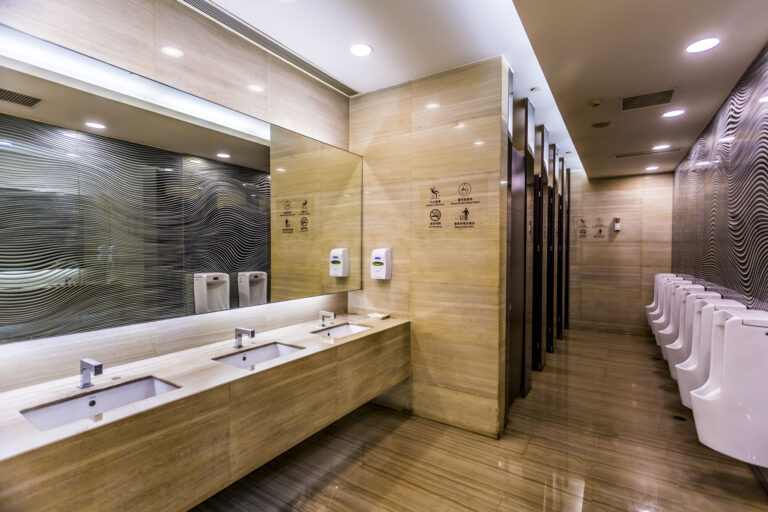Blog
How to Choose the Right Urinal for Your Commercial Space
Designing a public restroom in a commercial setting goes far beyond just installing a few fixtures and hoping they serve the purpose. The urinals you choose can influence hygiene, user experience, and even how your brand is perceived. For property managers, architects, and business owners, selecting the right urinal is a critical part of restroom planning.

With so many models, mounting styles, and water-saving technologies available, choosing the right urinal can seem overwhelming. This blog will help you make sense of the options by walking you through essential considerations like usage needs, water efficiency, materials, installation styles, and accessibility—so you can choose the best commercial urinals for your space with confidence.
1. Assess the Needs of Your Commercial Space
Start by understanding the type of environment the urinals will serve. Different spaces have vastly different usage demands. A large shopping mall or stadium may require a higher number of durable units, while a boutique office or small restaurant may prioritize sleek design and compactness.
Key factors to consider:
- Volume of daily users
- Type of users (employees vs. general public)
- Peak usage hours
- Available floor space
For high-traffic locations, it’s important to choose commercial urinals that are durable, easy to maintain, and quick to clean between uses. In smaller or design-centric environments, aesthetics and size may take priority.
2. Water Efficiency: Save Cost and Conserve Resources
One of the most important factors in choosing a urinal today is water efficiency. Traditional urinals use up to 3 gallons of water per flush, which leads to significant water waste over time. Fortunately, modern options offer impressive water-saving features without compromising on performance.
Types of water-efficient urinals:
- Low-flow urinals: Use 0.5 gallons per flush or less
- Waterless urinals: Use sealed cartridges to eliminate water use entirely
- Dual-flush systems: Allow adjustable water use depending on the need
Water-efficient fixtures not only cut down on utility bills but also align your business with sustainability goals—something more customers and tenants now expect in public restrooms.
3. Durability and Material Quality
When selecting urinals for your commercial facility, it’s essential to prioritize materials that offer both durability and ease of maintenance. Your urinals should be able to withstand repeated use throughout the day and hold up over time.
Common materials include:
- Vitreous china: Durable, stain-resistant, and easy to clean—ideal for most commercial applications.
- Stainless steel: Highly durable and vandal-resistant; often used in transport hubs and industrial settings.
- Ceramic with anti-bacterial coating: Offers enhanced hygiene in places like hospitals or schools.
Durable materials lower the long-term cost of maintenance and replacement. For commercial toilets and urinals, investing in quality upfront often leads to better performance over years of use.
4. Installation Type: Wall-Hung vs. Floor-Mounted
The choice between wall-hung and floor-mounted urinals depends on your restroom’s layout, available plumbing, and space.
Wall-Hung Urinals:
- Save floor space
- Easier to clean around
- Common in modern and smaller public restrooms
Floor-Mounted Urinals:
- Often found in older or high-traffic facilities
- Handle heavy use well
- Better suited for locations with existing floor plumbing systems
Each mounting type has its pros and cons, so make your choice based on your building’s structure, user flow, and maintenance needs.
5. Hygiene Features That Make a Difference
Hygiene plays a crucial role in the reputation of any commercial restroom. Touch-free and easy-to-clean urinals make a huge difference in user satisfaction and sanitation.
Look for features like:
- Sensor-based flushing systems: Minimize touchpoints and reduce germ spread
- Anti-splash designs: Help keep the area cleaner and reduce odor
- Stain-resistant coatings: Maintain a fresh look throughout the day
Well-designed public restrooms not only promote better hygiene but also reduce cleaning time and frequency, easing the workload for your maintenance staff.
6. Accessibility and User Comfort
Every commercial restroom should be inclusive. Accessibility isn't just about ticking a box—it shows that your business values all users.
To make your space inclusive:
- Install at least one ADA-compliant urinal at an accessible height
- Add privacy partitions between urinals for comfort
- Ensure proper spacing for easy movement and safety
Comfort and accessibility go hand in hand. A thoughtfully designed layout increases user satisfaction and helps your facility stay compliant with regulations.
Choosing the right urinal for your public restroom requires a balance of practicality, durability, design, and user comfort. From traffic levels and plumbing to hygiene features and accessibility, every element matters in a commercial environment.
At Monarch Bath, we understand the demands of modern facilities. We offer a range of commercial toilets and urinals built to deliver top-tier performance, modern design, and long-lasting sustainability. Whether you manage an office, school, retail complex, or healthcare facility, we offer reliable solutions that enhance both function and form.
FAQs
- What is the best urinal type for small commercial restrooms?
Wall-hung urinals are ideal for small spaces because they save floor space and are easy to clean around.
- Are waterless urinals a good option for commercial facilities?
Yes. They are eco-friendly, reduce water bills, and are effective when maintained properly.
- How do I maintain hygiene in a busy public restroom?
Choose urinals with anti-splash designs, sensor flush, and stain-resistant coatings. Regular cleaning and odor control are essential.
- What's the difference between commercial toilets and urinals?
Toilets handle both solid and liquid waste, while urinals are designed only for liquid waste and are more efficient for high-traffic male restrooms.
- Should commercial restrooms have ADA-compliant urinals?
Yes, at least one ADA-compliant urinal should be installed to ensure accessibility for people with disabilities.



















